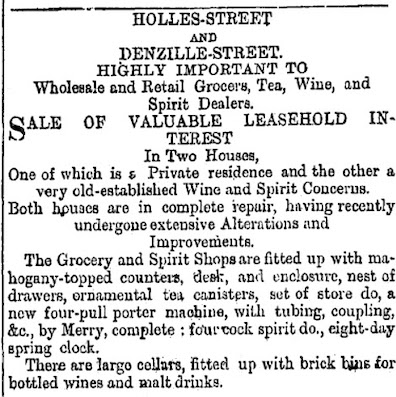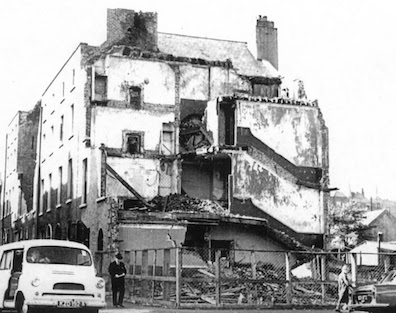In response to the Ruskin-like language comparing the violent
rainstorm to "the transformation, violent and instantaneous,
upon the utterance of the Word," Stephen "outflings" a word
that will violently and instantaneously transform the mood of
the medical students in the common room: "Burke's!" This pub
lay only a couple of blocks north of the maternity hospital,
on the corner of Holles Street and Denzille Street (now Fenian
Street), and in the final paragraphs of Oxen of the Sun
the hour is approaching "Closingtime." The young men
erupt from the hospital oblivious of everything else.
No photograph of Burke's pub is known to exist. William York
Tindall missed it when he brought his camera to Dublin in the
1950s and early 60s, despite taking pictures of the nearby
maternity hospital. The business had a corner porch entrance,
like O'Rourke's
on Dorset Street, and an 1874 advertisement for the
property lists various recent improvements in the interior,
including "mahogany-topped counters," "a new four-pull porter
machine," and "large cellars, fitted up with brick bins for
bottled wines and malt drinks." But years of decline in the
1930s, 40s, and 50s doomed it to the wrecking ball and there
is no clear picture of what it was once like––as is perhaps
fitting for the end of Oxen, where chaotic slang
obliterates any clear sense of the surroundings.
In a page on JJON Harald Beck reports what little is
known about the business. John Burke, then 50, listed himself
as a "grocer" (in the Irish sense of "spirit grocer") on the
1901 census, living at 17 Holles Street with three assistants.
He had bought the property in 1874, and he sold it in 1905.
"It was on the market again in 1925 advertised as 'Important
corner Licensed Premises', along with the adjoining property,
number 16. By 1935 it was vacant, but still advertised as
'Well-situated Licensed Property' in 1937. Number 16 was a
tenement by that time. / In 1966 the building had become
derelict and was demolished in the following year. It was only
then that a photographer found its disappearance a subject of
interest, its remaining 'good lofty cellarage with arched
vaults' newly filled with rubble."


